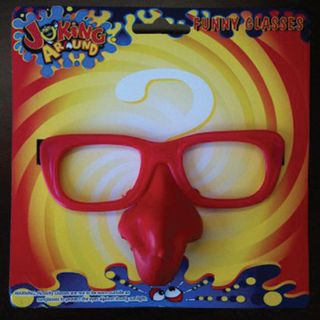The Most Dangerous Toys of 2011

Each fall, public safety experts from U.S. Public Interest Research Group (PIRG), the federation of state public interest research groups, browses toy stores across the country looking for potentially dangerous toys. Despite the stringent regulations imposed on toy manufacturers in the United States, these experts never fail to find a handful of items on store shelves that appear innocuous, but actually pose toxic, choking, strangulation or excessive noise hazards to children. The team, led by public health advocate Nasima Hossain, detailed their findings for 2011 in a year-end report and in correspondence with Life's Little Mysteries, a sister site to LiveScience.
So, as you're going cart-to-cart with other parents during the next two weeks, crossing items off your child's Christmas list, here's a list of toys not to fight over in the store aisles.
Not-so-funny glasses
Goofy disguises aren't so funny when they contain toxic chemicals. U.S. PIRG discovered that a glasses-and-fake-nose set manufactured by "Joking Around" contained 42 times the legal limit of phthalates — chemicals used to increase the flexibility of plastics. Worse still, a pink sleep mask sold at Claire's contained 77 times the legal phthalate limit.
The use of phthalates in toys was severely restricted in 2008 after studies by the Environmental Protection Agency showed they can cause developmental problems in fetuses and children.
"If you think about it, when you go to Target or Kmart, most toys in the baby and kids section are made out of plastic, and so up until the 2008 law got enacted, the market was cluttered with products that had phthalates in them," Hossain told Life's Little Mysteries. Manufacturers have since been required to find substitutes for phthalates, she said, but clearly some products containing them still end up on store shelves.
'Little Hands' lead book
Sign up for the Live Science daily newsletter now
Get the world’s most fascinating discoveries delivered straight to your inbox.
A cardboard book intended for toddlers called "Little Hands Love Book" (Piggy Toes Press, 2009) was found to contain 720 parts per million (ppm) of lead. This was more than twice the legal limit (300 ppm) at the time of the book's printing, and more than seven times the prospective legal limit, which was recently set at 100 ppm. Furthermore, a toy called the Whirly Wheel, manufactured by LL, was found to contain an astonishing 3,700 ppm of lead — 37 times more than the newest legal limit. Several other toys (including a Disney Tinkerbell watch, a Honda model motorcycle, and a Hello Kitty keychain) contained quantities of lead that were below the legal limit, but over the limit recommended by the American Academy of Pediatrics (40 ppm).
"Toxicity is the biggest danger posed by toys. [Manufacturers] use lead in plastics, and when this is exposed to air, it rubs off on the skin and children can breathe it in," Hossain said.
Toys too small for tots
Since 1990, 57 children have died from choking on small toys or toy parts. For this reason, the U.S. Consumer Product Safety Commission (CPSC) imposes strict regulations on the minimum size of toys intended for use by children — especially children under age 3. Nonetheless, U.S. PIRG safety experts found several toys on the market that did not meet these size requirements, and thus posed choking hazards for children. Among them was a wooden block set made by ToySmith and an Oscar the Grouch doll made by Sesame Workshop. [The Cool Physics of 8 Classic Toys]
Many other toys found by the group lacked the necessary warning labels about choking hazards (which must be placed on the packaging of toys for children ages 3 to 6); this serves as a reminder to parents that they must always consider the safety of toys themselves before buying them, rather than taking labels — or the lack thereof — at their word.
Small ball hazard
Small bouncy balls and marbles have caused 69 choking deaths since 1990. Consequently, small balls meant for children under age 3 must not be able to fit through a 1.75-inch-diameter test hole — which approximates the size of a child's wind pipe — and balls meant for older children must come with choking hazard warning labels. Nonetheless, when perusing toy bins across the country, the U.S. PIRG experts came across several balls that did not meet these requirements, again suggesting that parents must be extra vigilant when buying small balls or marbles for their kids. [Is There a Santa Claus?]
Burst balloons
Balloons are all fun and games until they burst. Pieces of burst balloons pose a choking risk for children under 8 years of age, and have caused 86 deaths since 1990. For this reason, U.S. PIRG recommends keeping balloons away from young children completely, and was discouraged to find balloons in stores that were being marketed for infants' and toddlers' birthday parties.
Quiet down, toys
The CPSC places strict regulations on the maximum sound level that may emanate from toys, because excessive noise can damage a child's hearing. "Even minor hearing loss in children can affect their ability to speak and understand language at a critical time in their development," the U.S. PIRG report explained. According to the law, "close-to-the-ear" toys must have volumes less than 65 decibels (dB), and toys played with at a distance must be quieter than 85 dB (or 115 dB for short bursts of sound). However, several toys were found to violate these laws. The too-loud toys were an "Elmo's World" talking cellphone manufactured and sold by Fisher Price, Victorious stereo headphones from Nickelodeon and the Super Stunt RAT BOMB from Hot Wheels.
This story was provided by Life's Little Mysteries, a sister site to LiveScience. Follow us on Twitter @llmysteries, then join us on Facebook.
Most Popular

